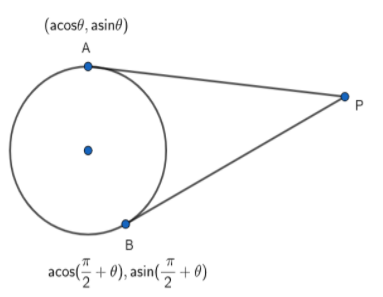Question
Question: The equation of a circle in parametric form is given by \[x=a\cos \theta \] , \[y=a\sin \theta \] . ...
The equation of a circle in parametric form is given by x=acosθ , y=asinθ . The locus of the point of intersection of the tangents to the circle, whose parametric angles differ by 2π .
(A) x2+y2=5a2
(B) x2+y2=2a2
(C) x2+y2=3a2
(D) x2+y2=4a2
Solution
Hint: Assume that A and B are the points of the tangency and the parametric angle of point A be θ and point B be β and the point of intersection of the tangents is P. The difference between the parametric angles β and θ is equal to 2π . Now, get the value of β in terms of θ . The parametric form of a point on the circle can be represented by x=acosθ and y=asinθ . Now, get the parametric coordinates of point A and point B. Square and add the x-coordinate and y coordinate of the parametric coordinate of the point on the circle. The equation of the circle is x2+y2=a2 . We know the formula, the equation of the tangent at the point (x1,y1) of the circle x2+y2=a2 is given by, xx1+yy1=a2 . Now, using this formula, get the parametric coordinates of the points A and B and get the equation of the tangents at the point A and B of the circle. Now, square the equations of the tangents AP and BP and add them. Solve it further and get the equation of the point of intersection of the tangents AP and BP.
Complete step-by-step answer:
First of all, let us assume that A and B are the points of the tangency and the parametric angle of point A be θ and point B be β and the point of intersection of the tangents is P.
According to the question, it is given that the difference between the parametric angles of point A and point B is 2π . So,
β−θ=2π
⇒β=2π+θ ………………………….(1)
It is also given that the parametric form of a point on the circle can be represented by
x=acosθ ……………………………(2)
y=asinθ ……………………………(3)
Since the parametric coordinate (acosθ,asinθ) lies on the circle, so it must satisfy the equation of the circle.
On squaring equation (2) and equation (3), we get
x2=a2cosθ ………………………….(4)
y2=a2sinθ ………………………….(5)
On adding equation (4) and equation (5), we get
x2+y2=a2cos2θ+a2sin2θ
x2+y2=a2(cos2θ+sin2θ) …………………………..(6)
We know the identity, cos2θ+sin2θ=1 …………………………….(7)
From equation (6) and equation (7), we get
x2+y2=a2.1
⇒x2+y2=a2
Now, we have got our equation of the circle, x2+y2=a2 .
We know the equation of the tangent at the point (x1,y1) of the circle x2+y2=a2 is given by,
xx1+yy1=a2 ………………….(8)
The parametric angle of point and point B is θ and β .
The coordinate of point A = (acosθ,asinθ) …………………………..(9)
From equation (1), we have the value of β .
Now, the coordinate of point B = (acos(2π+θ),asin(2π+θ)) ………………………………(10)

Using equation (8), we can get the equation of the tangent of the circle x2+y2=a2 at point A.
Now, the equation of the tangent at point A i.e, AP
x(acosθ)+y(asinθ)=a2
⇒xcosθ+ysinθ=a ……………………………(11)
Similarly, using equation (8), we can get the equation of the tangent of the circle x2+y2=a2 at point B.
Now, the equation of the tangent at point B i.e, BP
x\left\\{ a\cos \left( \dfrac{\pi }{2}+\theta \right) \right\\}+y\left\\{ asin\left( \dfrac{\pi }{2}+\theta \right) \right\\}={{a}^{2}}
⇒x.cos(2π+θ)+y.sin(2π+θ)=a ……………………………(12)
We know that, cos(2π+θ)=−sinθ and sin(2π+θ)=cosθ …………………….(13)
From equation (12) and equation (13), we get
⇒x(−sinθ)+y(cosθ)=a
⇒−xsinθ+ycosθ=a ………………………..(14)
Since the tangents at points A and B are meeting at point P so, the point P must satisfy the equation of the tangent AP and BP.
Now, squaring equation (11) and equation (14), and adding then we get
